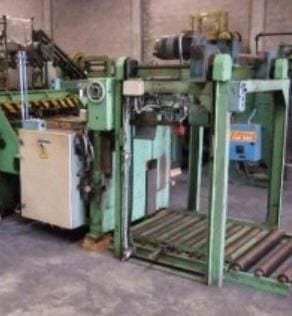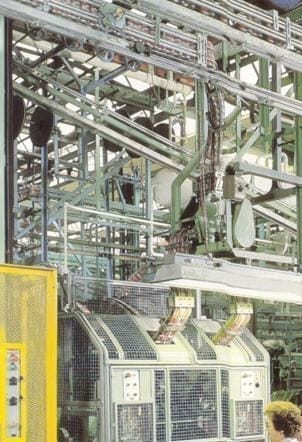Every day of hard work, we face different opportunities and challenging scenarios.
In the pursuit of operational excellence, we fight waste on a daily basis and this daily battle for productivity is directly related to maintenance, processes and people.
And that’s why we’re going to continue with the maintenance issue.
We will provide simple examples, which can make a difference in the search for efficiency, where we can perform scheduled maintenance and enjoy the results they can give us.
An example of basic maintenance that can make a difference when doing a Speedup on your decorator.
Let’s talk a bit about the transfer wheel, a sub-assembly located after printing the can and applying the external varnish.
The transfer wheel is a very simple but often overlooked subset of printer preventive maintenance plans.

The transfer wheel has the function of transporting the can from the printer to the attached chain without damaging the can and the print.
The programmed replacement of the main bearings, synchronized tensioning belts ensure smooth operation and availability of the sub-assembly.
Clearing vacuum channels, maintaining connectors, air and vacuum transfer tubes, changing and adjusting the manifold, replacing pads and suction cups are basic maintenance, which should be performed by the operation and make a difference in the daily journey of Spoilage control.
It is an area subject to fogging from all types of debris. Inks, lubricants and varnishes are constantly being sprayed in this area, so during a scheduled maintenance, perform a good cleaning to keep the equipment in good condition.
The lack of maintenance of this item can generate many inconveniences for the operation, such as greater deterioration in the equipment, possible generation of non-conforming products due to accumulation of cans that can be projected, speed limitations due to malfunction of the set.
Your preventive maintenance and adjustments are paramount.
For plants performing format conversion interventions, it is important to follow the distance setting recommended by the manufacturer.
The manufacturer of the equipment recommends the necessary distances that we must have for a good operation and we must be very careful, because in spite of having carried out a good maintenance, a badly adjusted equipment can be a source of spoilage and low efficiency.
Depending on the model of the decorator we have different types of transfer wheels. In this case we are talking about the Flat wheel, one of the simplest maintenance sub-assemblies on a decorator.
Pay attention to the signs that this sub-assembly may give, as the suction cups and vacuum cups suffer daily from the movement and pressure exerted by the can, and for autonomous maintenance they should be replaced more frequently. Vacuum supply should always be between 19 and 20 hg; lower values may cause loss of sub-assembly efficiency at high speeds.
Now we will see another basic and very important maintenance that directly affects the quality of the product.
For a printer to operate at high speed, it is necessary to have control over several variables.
With regard to printing, the most important thing is dot gain, which refers to the increase in the size of the halftone dots of an image, there is also the deformation and flattening of the dot.
Enlarged and/or deformed dots affect and reduce the sharpness of the printed image, changing the reproduction and contrast of the printout.
Dot gain is considered a normal feature of the printing process that cannot be completely eliminated, but is controlled and manipulated to achieve the desired print results.
To have this variable under control we must take care of our printing pressure and the subassembly that is directly connected to it called linear bearings.
These bearings are responsible for moving the chuck assembly, along with the cam follower bearings. Together they give support and stability to the assembly when printing.
This system allows working with reduced printing pressure (0.008″ to 0.012″), which provides a sharper and better quality image.
Each set of chuck has 2 linear bearings and the spindle disc has a total of 24 sets, giving us a total of 48 bearings, so please pay attention to the lubrication and cleaning of these sets.
With scheduled and disciplined maintenance, we can maintain the life of the linear bearing, however it is necessary to preventively replace grease retainers and varnish scrapers.
Avoid surprises and failures, as lack of routine maintenance for this item can lead to quality deviations and unnecessary machine downtime when you least expect it.
Below is an example of how a bearing performs under extreme conditions.
In cases like this, perform a complete replacement including one raceway and two bearings.
Always seek to follow the manufacturer’s recommended maintenance schedule.
The retainer ensures lubrication of the inner rollers and the varnish scraper ensures cleanliness of the bearing race.
By maintaining lubrication and cleaning routines it is possible to run for long periods without breaks and sudden stops.
Always include checking or replacing the skid plate, bearings, manifolds, air hoses and pockets of your chuck disc.
In a scheduled shutdown, whether short, medium or long term, we must take advantage of all the time available to leave the equipment in the best possible conditions for its operation.
In this way, we can provide a results machine, always ready to overcome the challenges and circumstances of everyday life in pursuit of operational excellence.
André Malta Alves
Mundolatas Advisor



















0 Comments